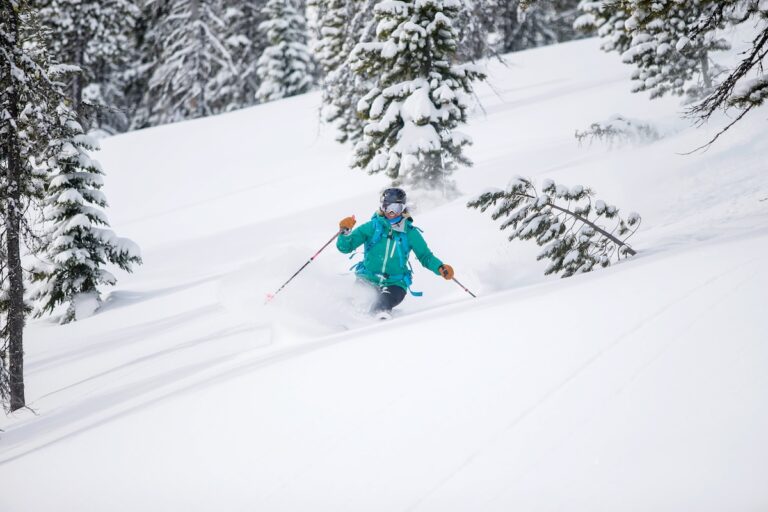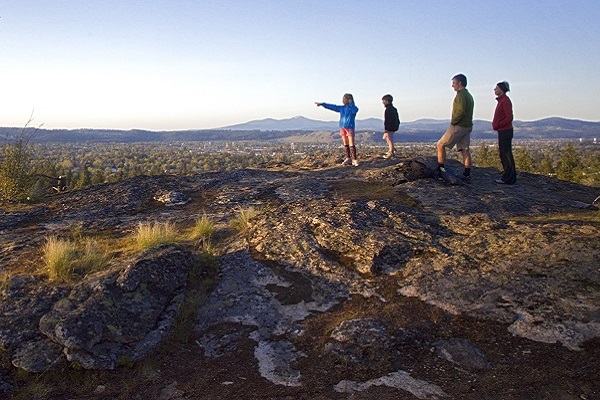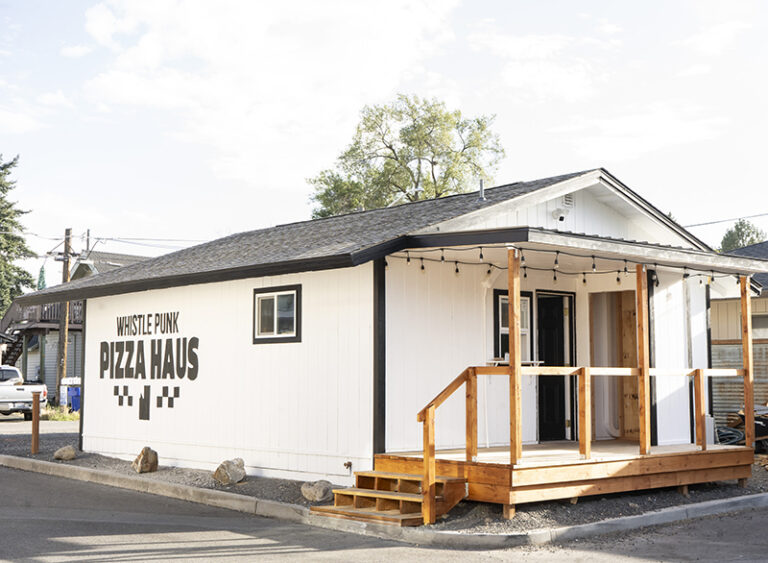An Inland Nw Round Hut Travel Guide
It’s February, and you’re itching to hit the road for an outdoor adventure. But sometimes in the colder, drearier months, the thought of packing up all of your gear—tent, rain fly, shovel, sleeping bag and pad, cook stove, propane, food, utensils, firewood, etc.—hauling it through deep snow, and setting up camp by lantern and headlamp doesn’t quite appeal. But guess what: you could have the same adventure, bring just a sleeping bag, ski gear and food—and stay in a warm, dry, inexpensive shelter you don’t have to assemble, equipped with bunks, electricity, chopped firewood, and cooking equipment.
The secret? Yurts. Yurts are round, tent-like structures—though much more sturdy and weather-resistant—that make easy outdoor adventures possible, everywhere from the backcountry to a state park.
Yurt design traces back thousands of years to the nomads of Central Asia, where yurts are still in use today. The original yurts had lattice walls encircled by tension bands or ropes, and were roofed with rafters that met in a central tension ring; the structure was covered with wool felt or animal skins. In recent decades, yurt popularity has taken off in the U.S. and internationally. The basic structure of a modern-day yurt hasn’t changed much, but the design has been adapted for wide-ranging user demands. Though some modern yurts are still quite primitive, many are outfitted with electricity, screened windows, skylights, kitchens, wood stoves, and sometimes even air conditioning. Today’s yurts showcase gorgeous natural woods and often make use of highly weather-resistant materials (some can withstand up to a 100-pound snow load). The largest are generally 30 feet in diameter. Prices range from a few thousand dollars up to $20,000+, depending how they’re outfitted.
With their highly adaptable design, yurts are being used as yoga studios, warming huts (there’s one at the Nordic Center at 49° North), guesthouses, shelter for migrant workers, in place of cabins and tents, and even as restaurants. For outdoor adventurers, yurts are ideal shelters that can extend a season through fall and winter—plus, yurts are known for being remarkably warm on cold or even sub-zero nights, when temperatures inside can easily be in the 60s or 70s. Cold isn’t an issue, says Leo Hennessy, the non-motorized trails coordinator for Idaho State Parks and Recreation, where a yurt and trail system makes simpler backcountry adventuring possible. “More of an issue is [being] too hot,” he says with a laugh.
“Yurts preserve the natural environment. They’re eco-friendly and low-impact and can be removed without a trace,” says Alan Bair, the president and founder of Pacific Yurts, Inc. in Cottage Grove, OR, the original manufacturer of the modern yurt. The company’s website, yurts.com, features yurt uses ranging from business properties to cabins to temporary housing. Bair, in fact, got into the yurt business decades ago when he and his wife bought property they couldn’t yet afford to build a house on. He’d become familiar with yurts through National Geographic and decided to build one, which they lived in. The yurt drew coverage from local publications, people asked Bair if he could build them one, and like that, business took off. “Without even knowing what an entrepreneur was, I became one,” he says.
Yurts’ greatest appeal is inherent in their round shape. “The yurt itself is a very unique structure—people almost have this spiritual feeling in them,” Hennessy says. Bair feels similarly. “Some people consider it a type of sacred geometry—it carries your eye up the lattice wall and up the rafters to the center—to the stars at night, the sun during the day. There’s a special feeling there.”
Kent Hoffman of Spokane Valley has a yurt in his backyard, which he uses for writing and for meditating. “I’ve always loved them,” he says. “There’s something about being in a building with circles. It’s like you’re inside but also outside. It’s the most replenishing architecture I can think of. It’s definitely a retreat.”
Caspian Ashby, a former Spokane resident who lived in a traditional Mongolian yurt in a friend’s backyard through a Montana winter, loved her experience. “The only reason I moved out was to relocate to Oregon to be nearer to my now fiancé,” she says. “The yurt allowed me to simplify my life and focus on myself and the things that are important to me.”
“It amazes me also that yurts are such sound, durable structures, yet they can be dismantled, moved and reassembled fairly easily,” Ashby says. “This appealed to me, being the modern nomad that I am.”
Hennessy notes that yurts are excellent at bringing people together—a good thing in a camping, vacation or backcountry experience. “When you’re in the yurt, everything is kind of in the middle,” he says. “You have to look at each other. You can’t hide. You have to really like the person you’re with.”
It was the desire to create a memorable group experience that led Lisa Whisnant and her husband to start a yurt restaurant about 16 years ago, Blue Moon Yurt, in Ponderosa State Park near McCall, ID. River guides in the warmer months, the couple wanted to create a wintertime group bonding adventure, similar to what can happen with a bunch of strangers on a multi-day river trip. An evening at Blue Moon Yurt means a group gathers in a parking lot at 6:00 pm before skiing or snowshoeing to an off-grid yurt in the forest, where, for the next several hours, guests enjoy a four-course candlelight meal before following the snowy trail back to their cars.
“The activity of getting there, sitting with people they don’t know…it’s a catalyst to get people to talk. We love that group dynamic and the whole buzz that goes on between people,” Whisnant says.
Whether they’re used as restaurants, temporary shelters or retreats, yurts lead to unforgettable experiences. Bair recalls an adventure he had years ago. He’d been skiing all day and, armed with a topographical map, was on the lookout for the yurt he planned to stay in that night. It was getting cold. “I was feeling like if we didn’t find it soon we’d be spending the night in a snow cave,” Bair says, “when there it was, around a hillside. We went inside, made a fire—underneath the deck there was stacked wood—made hot chocolate, and pretty soon we were snug as a bug in a rug.”
For your own unforgettable yurt adventure, read on to learn about some of the many accommodations in the Inland Northwest—and a few beyond in the surrounding region. Rustic outings not your thing? Check out Washington State’s posh yurt accommodations.
MORE RUSTIC YURT EXPERIENCES:
Make reservations well in advance.
WASHINGTON
WASHINGTON STATE PARKS
Where: Cape Disappointment, Grayland Beach, Kanaskat-Palmer, Paradise Point, and Seaquest (all in Western Washington).
Accommodations: Each yurt is 16-feet in diameter by 10-feet high and is furnished with bunk beds that sleep three, a queen-size futon, overhead light, and small end table. Outside you’ll find a picnic table, fire grill, utility hookup, and a deck (disabled-accessible). Bathrooms and showers nearby. Yurt rentals are available year-round; cost is $65-70/night May 15-Sept. 15 and $55-65/night Sept. 16-May 14.
What to bring: Your usual camping supplies. Pack blankets and warm clothing for the often-chilly evenings.
More info, directions and reservations:
www.parks.wa.gov/yurtsandcabins
IDAHO
BACKCOUNTRY IDAHO
Where: Idaho State Parks and Rec’s backcountry yurt system, in Boise National Forest near Idaho City; 7.5 hours from Spokane but worth the drive.
Accommodations: Six backcountry yurts that sleep six available year-round; cost is $75/night weeknights, $90/night weekends. Covered outhouses at each yurt. Pets allowed in four of the six yurts.
Why go: For your own private slice of wilderness. These yurts, spread along a backcountry trail system, are accessible only by hiking, skiing or snowshoeing 1.5-3 miles from the parking lot area. You’ll enjoy plenty of privacy and untracked snow; decks offer stellar mountain views. Take advantage of the 60-mile trail system and Telemark or Nordic ski, hike or snowshoe in the winter; mountain bike, horseback ride, and swim in the creeks in warmer months.
Beware the seasons: Hennessy advises winter visitors to come in four-wheel or all-wheel drive vehicles and bring a shovel. Summer is perfect for new outdoorspeople—“It’s a beautiful place to take a family for the first time,” he says.
What to bring: A sleeping bag and food, and your skis, bike or snowshoes. Provided for you are furniture (including futons and bunks, tables and chairs), propane cooking stove, utensils, and even cookware such as woks.
What to do nearby: Visit Idaho City, an old mining town with fake-front and historic buildings, ice cream shops, museums and shopping. And plan to clean up after your yurt stay in one of the area’s hot springs (visit www.idahohotsprings.com for ideas).
More info, directions and reservations:
http://parksandrecreation.idaho.gov/lodging/backcountryyurts.aspx
IDAHO STATE PARKS
Where: Winchester Lake, Cascade, and Harriman.
Accommodations: Each park’s yurts are heated and furnished. Winchester Lake’s yurts (Western Idaho) sleep up to five; no pets; outdoor grill for cooking. $50-65/night. Harriman (Eastern Idaho) offers yurts that sleep up to six; wood stove and propane appliances available for light and cooking. $50/night. Group yurts are available at Lake Cascade’s Osprey Point (Western Idaho), ideal for family reunions and retreat groups. $175/night for the rental of three yurts (accommodates up to 30).
Why go: Cross-country skiing and other outdoor fun. Check the website for each park’s specifics.
What to bring: Your usual camping supplies; details online.
More info, directions and reservations:
http://parksandrecreation.idaho.gov/lodging/yurts.aspx
OREGON
WALLOWA LAKE STATE PARK
Where: Wallowa Lake in Northeastern Oregon, about 4.5 hours from Spokane. Accommodations: The two heated yurts at Wallowa Lake State Park are round cedar-sided buildings. Both have sky lights to let in natural light. Futon and bunk beds sleep five. Deck with covered picnic table; nearby fire pit for cooking and campfires. Yurts are available year-round; cost is $38/night. No pets in the yurts. Restrooms and heated showers nearby.
Why go: The Wallowa Lake area has been called the “Alps of Oregon.” Enjoy breathtaking views of the Wallowa Mountains, wilderness trails for hiking, biking, horseback riding, and cross-country skiing, and, of course, the lake.
What to bring: Your usual camping supplies.
What to do nearby: There is lots of summer fun in the Wallowa area. Check out Chief Joseph Days Rodeo, Fishtrap writers and reader conferences, TamKaLiks Celebration (recognizing and celebrating the Nez Perce presence in the valley), farmers’ markets, the Bronze Bike Motorcycle Rendezvous, music concerts and art festivals, and the county fair. Hells Canyon Recreational Area is not far from Wallowa Lake State Park; take advantage of the scenic driving routes.
More info, directions and reservations: For more about Wallowa Lake, visit www.oregonstateparks.org/park_27.php. For info about yurt stays in Western Oregon state parks, go to oregonstateparks.com or call (800) 551-6949.
MONTANA
BIG ARM STATE PARK
Where: On the west shore of Flathead Lake in Big Arm State Park, 3.5 hours from Spokane. Accommodations: Three yurts (six-person and four-person) available May 1-Sept. 30. $55-60/night ($45/night for Montana residents); one yurt is disabled-accessible. Minimum two-night stay. Futons and rollaway beds or bunks for sleeping. Yurts are outfitted with lamps, tables and chairs, and offer electricity and baseboard heat. Cooking is done outside. One restroom shared by all three yurts. No pets allowed inside.
Why go: To boat, swim or fish. Flathead Lake, the largest natural freshwater lake west of the Mississippi, is the biggest draw of the area. Paved roads are comfortable for biking. Hike or horseback ride along the 2.5 miles of shoreline trails.
What to bring: Your usual camping supplies.
What to do nearby: The town of Polson is less than 15 minutes away and offers community theater (Port Polson Players Theater), shopping and dining, and golf at Polson Bay Golf Club, a 27-hole public course with impressive lake views. Kalispell is about 40 miles north of Big Arm, and Whitefish is about 15 miles beyond that.
More info, directions and reservations:
http://fwp.mt.gov/parks/accommodations/
yurts.html. Reservations can be made beginning March 16.
YURTSKI BACKCOUNTRY LODGING AND SKIING
Where: Deep in the Montana backcountry, near Seeley Lake (about 4 hours from Spokane, an hour from Missoula).
Accommodations: Two yurts at 6,600’ and 6,800’ in the Southern Swan Mountains, accessible via snow machine or skis. Each yurt sleeps eight, is heated by a wood-burning stove, has a kitchen (stocked with a cook stove, utensils and cookware), and an outhouse. Yurtski offers packages that include gear hauls, guided tours, and gourmet prepared meals, or you can opt for a “self-sufficient yurt rental” and do your own thing. Yurt rentals start at $40/night; full service packages cost $150. Check website for minimum group size/yurt.
Why go: Backcountry skiing with stunning views of the Mission and Swan Mountains and the Bob Marshall and Scapegoat Wilderness. A 30-45 minute hike from your yurt brings you to a ridge; from there, a variety of runs take you back to your yurt’s front door.
What to bring: All of your backcountry skiing supplies, sleeping bag, food and most of your usual camping gear, minus cook stove and utensils; check www.yurtski.com for details.
More info, directions, and reservations:
www.yurtski.com
MORE LUXURIOUS YURT STAYS:
Make reservations well in advance.
CHIWANA VILLAGE AT SAGECLIFFE
Where: SageCliffe is located on the Columbia River Gorge (2.5 hours from Spokane) and is home to Cave B Estate Winery, Cave B Inn, Tendrils restaurant, a spa, and—for yurt stays—Chiwana Village.
Accommodations: The yurts at Chiwana Village overlook either the Columbia River or the vineyard and feature king-size beds, sky domes for stargazing, private baths, sitting areas, and patio decks. Wheelchair-accessible yurts and Wi-Fi are available. Chiwana Village is open April-October, weather permitting. Prices (excluding Gorge concert weekends) range from $150-200/night.
Why go: For a luxurious yurt experience in the middle of a vineyard. You’ll be able to enjoy wine tastings, fine dining at Tendrils, and spa treatments. Complimentary cruiser bikes are available to guests, who can also enjoy bocce ball, a horseshoe pit and swimming. A popular hike winds down the cliff to the river.
What to bring: What you’d pack for a hotel. Though the yurts include mini-fridges, they don’t have cooking facilities.
More info, directions and reservations:
www.sagecliffe.com or (509) 785-2283
NETTLES FARM AT THE WILLOWS INN (LUMMI ISLAND)
Where: Willows Inn and Nettles Farm are located on Lummi Island in the San Juans, in northwest Washington. Ferry service is only available from Bellingham, two hours north of Seattle. It’s only a five-minute ride, with departures every 20 minutes on weekdays and every hour on weekends and holidays. (Whatcom County ferry info: www.co.whatcom.wa.us/publicworks/ferry/index.jsp)
Accommodations: There is one yurt on the property at Nettles Farm (there is also a cabin and a suite available, and Willows Inn is a short walk away), fully equipped with a queen-size bed, couch, and a kitchen with refrigerator, stove, sink, island counter and utensils. The yurt is available year-round; cost is $140/night (minimum two-night stay) and includes breakfast for two.
Why go: To be close to nature without roughing it. Enjoy gorgeous San Juan Island views, a seven-mile bike loop (complimentary bike use available), or a hike along the Baker Mountain Trail. Spend time with the farmer at Nettles Farm, and, of course, eat at Willows Inn (recently featured as one of the New York Times’ “10 Restaurants Worth a Plane Ride”), where they use local and seasonal foods, like Nettles Farm vegetables. As you dine, you’ll look out on fishermen catching seafood for Willows Inn’s next meal.
What to bring: What you’d pack for a hotel, plus food (you can purchase some food from Nettles Farm).
More info, directions and reservations:
www.willows-inn.com
YURT DINING
BLUE MOON YURT
Those looking for an unforgettable yurt experience that doesn’t require an overnight stay should check out McCall, Idaho’s Blue Moon Yurt, just over 4.5 hours from Spokane. From December through March, groups (up to 26) meet a guide at 6:00 pm prepared to snowshoe or Nordic ski to a yurt about a mile away, in Ponderosa State Park. Tiki torches light the way along the designated ski trails. The 24-foot diameter yurt restaurant is furnished with three family-style tables and lit by candlelight and propane lanterns. Appetizers and four courses are served; guests bring their own alcohol. After dinner, ski or snowshoe back to the parking lot. The whole evening takes about five hours and costs $90/person. Reserve well in advance.
More information, directions and reservations: bluemoonyurt.com or (208) 634-3111
VISIT A NEARBY YURT
49° NORTH MOUNTAIN RESORT’S NORDIC CENTER
49° North Mountain Resort’s Nordic Center (Chewelah, WA, an hour and 20 minutes from Spokane) offers 25 km of groomed trails for cross-country skiing, and ungroomed trails for snowshoeing—and they use a yurt as their warming hut. The yurt has been there for about five years, says Nordic Director Doug Elledge, and is well worth a visit. Take a break after a morning of skiing and get cozy in the 24-foot yurt, which is outfitted with lockers, tables and chairs, and a wood stove; some beverages and snacks available. More information: www.ski49n.com













